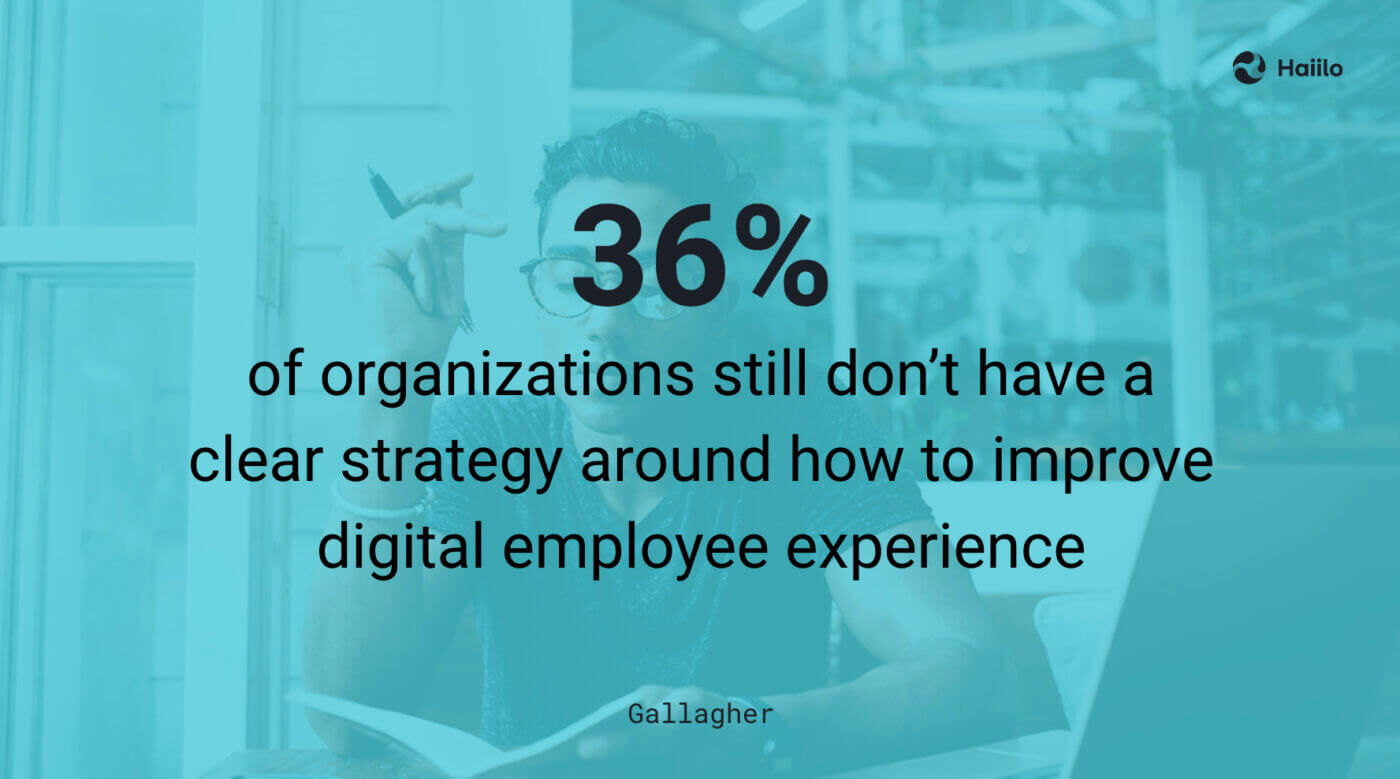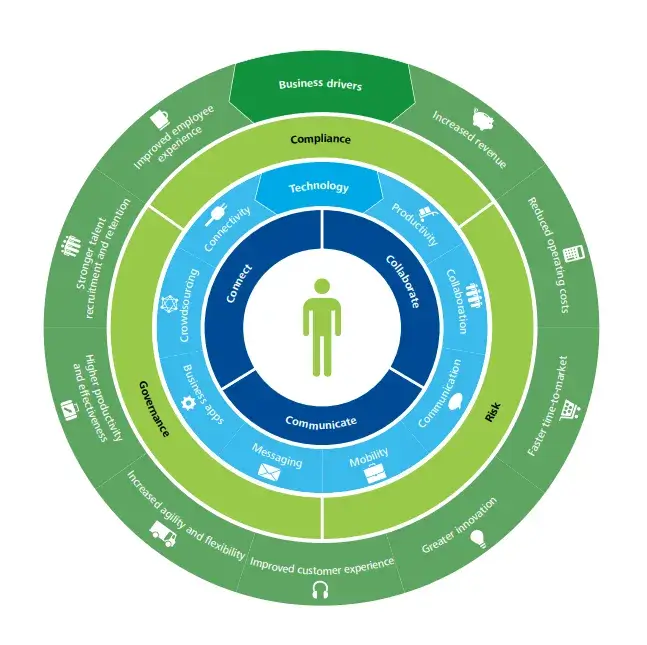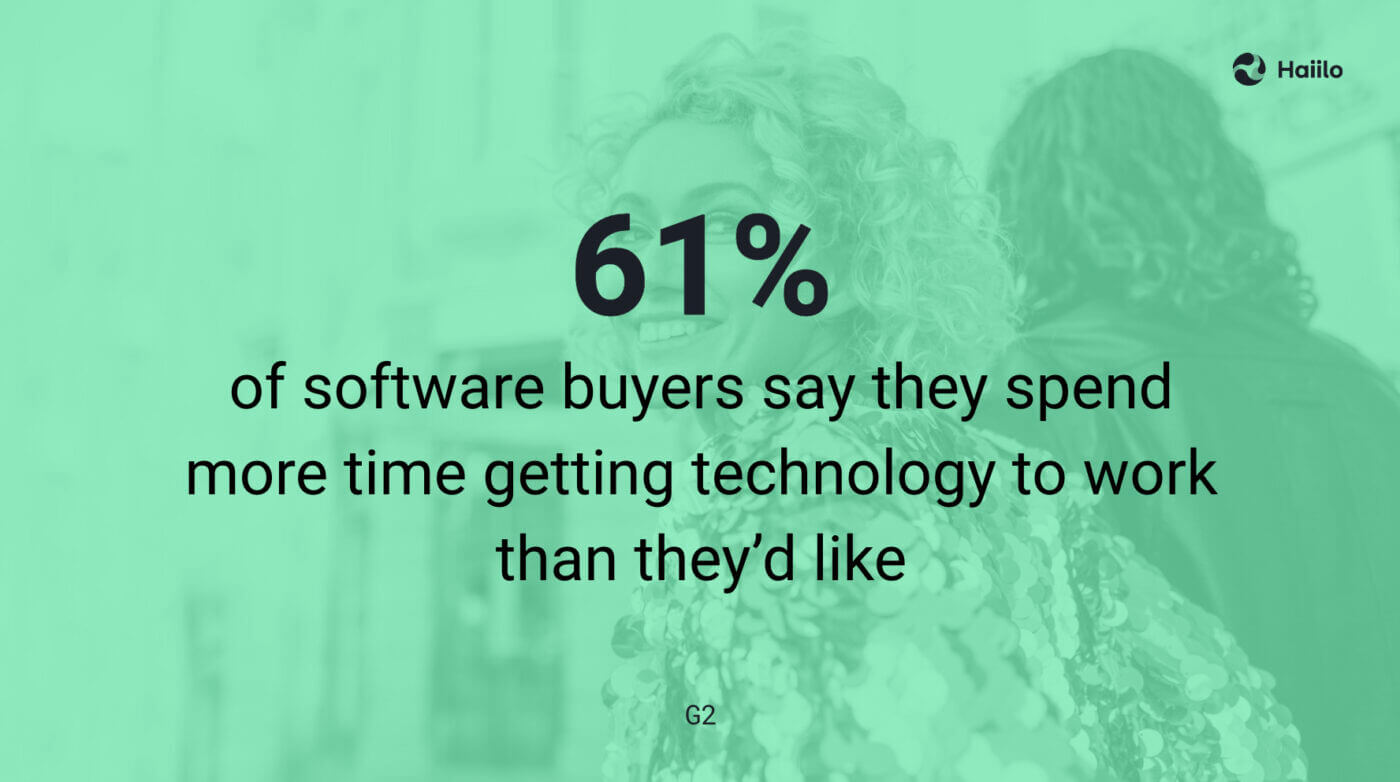Digital employee experience plays a critical role in shaping the overall employee experience in the workplace. Today, when employees depend on technology to communicate, collaborate, and get their work done, it is essential that organizations put more effort into enabling their people with the right technology.
Unfortunately, according to Gallagher, dissatisfaction with internal technology and channels is one of the biggest problems for larger organizations with more than 500 employees, resulting in poor digital employee experience. Yet, 36% of organizations still don’t have a clear strategy around how to improve it.
In this comprehensive guide, we define digital employee experience (DEX), explain why it is important, how to measure it, and how to improve digital employee experience. We also include some of the best platforms to use for optimizing the ROI of your workplace tech ecosystem.

What is employee experience?
Before we define digital employee experience (DEX), let’s clarify employee experience (EX) — which is the quality of an employee’s interactions, feelings, and perceptions throughout their entire journey at a company.
It includes everything from recruitment and onboarding through ongoing activities like learning and development to offboarding. A positive employee experience increases employee engagement and employee retention.
What is digital employee experience?
Digital employee experience (DEX) is how employees interact with technology, tools, and digital resources in the workplace. It refers to the overall perception of the usability and benefits of the tools employees use daily, including:
- Tools/systems – Software, hardware, employee platforms, and systems used to do their jobs;
- Ongoing experience – Ease of use of these tools, support for workflows, reliability of tools;
- Personalization – Ability to customize tools to individual needs and preferences;
- Mobility – Accessing tools/resources from any device, such as desktop or mobile apps, and location;
- Skills/training – Opportunities to learn digital skills and optimize tool proficiency.
The goal is to increase employee productivity, collaboration, and engagement at the workplace. An excellent digital employee experience can attract top talent and increase engagement,job satisfaction, and employee retention.
Deloitte did one of the most comprehensive analyses of the emergence and characteristics of a digital workplace.
In their framework, they explain that a digital workplace is all about the employees’ ability to do their jobs by collaborating, communicating, and connecting with each other, driving loyalty and retention.

Other experts in the space of workplace technology also agree on the importance of technology in shaping the overall employee experience.
Harvard Business Review goes as far as equalling the technology to the workplace itself:
“As this trend persists, the technology experiences that employers provide will more or less define the employee experience — technology and workplace tools are, for all intents and purposes, the new workplace. As such, they’re becoming central in attracting and retaining new talent, fostering workplace culture, creating productivity, and more.”
Why is digital employee experience important?
Digital employee experience is important as it impacts how employees do their jobs, directly affecting their productivity, engagement, and collaboration. When implemented poorly, technology in the workplace often presents users with a disjointed, frustrating experience.
Organizations can streamline and simplify employee communication by leveraging modern technology and establishing cross-functional, enterprise-level governance. It can foster greater engagement and drive more productivity in the front and back office, as well as between on-site, remote, and frontline staff.
Here are the top reasons why digital employee experience is so important.
1. Employee satisfaction and engagement
According to a study by Ultimate Software, 92% of workers said having technology that makes their jobs easier impacts their happiness with their jobs.
However, according to Qualtrics research, only 30% of employees said their experience with their company’s technology exceeds their expectations.
On the other hand, when employees are satisfied with their IT services and technology experience they are 158% more engaged at work.
📹 Check out our Masterclass about how to drive employee engagement in the workplace.
2. Employee productivity
Employees who work for firms that make apps available and highly accessible spend 17% less time on manual processes. Furthermore, solutions such as social intranets significantly reduce time wasted on searching for information and improve knowledge management, all resulting in higher employee productivity.
3. Employee retention
54% of CIOs agree that the ability of their workforce to easily access business applications has reduced attrition rates. Another research proved that employees have a 61% higher intent to stay with their employers if they feel they have the technology that supports them at work.
4. Talent attraction
Last but not least, 80% of employees prefer to work for digital leaders. And this is not limited to millennials and gen Z but applies across the multigenerational workforce.
Try Haiilo to boost digital employee experience in your organization!
How to measure digital employee experience?
There are multiple ways to measure the digital employee experience and gauge employees’ feelings about the tools used, processes, and implementation. Here are some ways companies can measure digital employee experience:
- Use employee listening features – Intranet platforms like Haiilo usually include features like this to gauge how employees are feeling;
- Pulse/sentiment employee engagement surveys – Regular short surveys to measure satisfaction with specific tools/resources and sentiment over time;
- Track adoption metrics – Track usage levels of tools, time to onboarding completion, and task completion rates;
- Participation levels – Metrics like views, comments and contributions on the social intranet platforms;
- Retention tracking – Compare changes in digital tools to employee retention patterns;
- Qualitative interviews – Speak directly to employees to deeply understand specific experiences;
- Workforce analytics – Gather aggregated data on tool/system usage directly from platforms;
- Benchmarking – Compare key employee experience metrics to competitors or industry standards over time;
- Net Promoter Score (NPS) – Calculate an NPS by asking how likely employees are to recommend tools to coworkers.
The goal is to understand employee sentiment, adoption of software and resources, common issues and how the overall experience impacts engagement, productivity and retention over time. Both leading and lagging indicators provide a complete picture.
Digital employee experience management
Digital employee experience management and monitoring involves strategically aligning technology tools and resources to optimize employees’ work. The key aspects of the digital employee experience management include:
- Implementing the right solutions;
- Gathering feedback;
- Analyzing metrics on tool usage and performance;
- Addressing friction points;
- Continuously enhancing the digital tools and support to employees.
Digital employee experience management can help ensure the effectiveness of the tools implemented.
How to improve digital employee experience?
There are several ways to improve digital employee experience, including conducting employee engagement surveys, using intranet dashboard and tools, benchmarking, and tracking key metrics.
Many employers still struggle to transform their organizations into true, functional digital workplaces. The workplace tech ecosystem has become very complex, and there is no one-size-fits-all approach to follow.
However, there are a few critical steps every company should consider when implementing or improving their digital employee experience strategies.
1. Implement an employee experience platform
Implementing a unified employee experience platform allows workers to interact, collaborate, and communicate efficiently with the organization and increase both engagement and productivity. An employee experience platform is essentially an intranet platform, but with additional purpose-built capabilities for directly improving employee journeys and the overall digital workplace experience.
Leveraging an employee experience platform in your company can significantly improve digital experience in the following ways:
- Centralized access to information and tools;
- Personalized digital experiences (customizing the interface based on employee roles, locations, and needs);
- Features like employee feedback surveys, recognition, and goal-tracking help boost engagement;
- Simplified digital workflows to reduce manual tasks, increasing productivity;
- Accessibility via any device allows connectivity no matter employees’ physical locations;
- Analyze tools usage data to provide actionable insights to optimize digital employee journeys (based on real needs);
- Social features to foster stronger connections;
- Automating processes like digital onboarding.
Overall, a good employee experience platform streamlines and elevates the employee’s digital interactions with their workplace.
2. Consider a company mobile app
Leveraging an employee app is another way to enhance digital experience and communication. A company app is a mobile-first platform that centralizes internal tools, resources, and communication, creating a digital workspace for engagement across any location or device.
There are employee apps for different purposes. For example, Haiilo company app empowers companies to drive employee experience and engagement, Slack is predominantly for instant messaging, and Flock combines messaging with calendar scheduling.
Here are some of the key ways a mobile employee app can improve the digital employee experience:
- Centralized access to information: A single digital hub where employees can access all the tools, resources and information in one seamless experience on any device;
- Personalized digital experiences: Most employee apps allow some level of customization so employees see tailored and relevant content;
- Simplified internal communication: In-app messaging, announcements, and communities foster a sense of belonging and connection;
- Access from anywhere: Allows employees to engage with any device from any location (for remote, hybrid work setups, and frontline employees);
- Gamification: Some employee apps include features like points and achievements that increase collaboration.
So, in essence, company mobile apps bring consistency, personalization and mobile accessibility to improve the overall digital employee experience in an intuitively engaging format.
3. Deliver personalized experiences
Implementing your organization’s digital employee experience strategy is also about understanding your workforce, their preferences, cultural differences, and the nature of their jobs.
Today, workplace technology is still not providing consumer-grade, personalized user interfaces. Workplace programs aren’t reaching their potential due to lack of personalization resulting in low user adoption and engagement.
You can start with distributing a simple employee survey which can help you identify the current state of your employees’ digital experience and get insights about what is missing or needs improvement.
Only then you can deliver more personalized experiences that employees expect. But why is this so important?
Advanced workplace engagement apps, communication platforms, and productivity tools that focus on personalization can go a long way in making one’s working experience more enjoyable.
For example, with Haiilo you can create personalized news feeds based on employees’ interests, preferences, locations, languages, and much more. Internal communications and HR professionals can create and distribute personalized content to the right employees at the right time, resulting in much better readership and engagement. They can orchestrate content and communication across employee journeys.
4. Implement the right workplace tech stack
27% of workers estimate they lose up to an entire day every week on irrelevant emails and messages. Many remote and hybrid workers complain about the inability to connect with their teammates and collaborate efficiently.
These most common complaints from employees have shaped the list of some of the must-have workplace technologies every organization should have:
- Modern employee intranets that enable employers to connect their people, information, and tools under a single platform
- Instant messaging tools that help employees communicate synchronously
- Workplace productivity and project management software to help employees collaborate on projects and track their progress
- Document management systems to help organize and manage important company documents and files
5. Invest more in integrations
Integrations are critical for ensuring a seamless digital employee experience.
According to research, 70% of workers report having to enter the same data in multiple systems to get their job done, and the main culprit for that is a lack of integrations between the technology they work with daily.
As nicely put by Deloitte,
“By integrating the technologies that employees use, the digital workplace breaks down communication barriers, positioning you to transform the employee experience by fostering efficiency, innovation and growth. The key to success, however, lies in the effective implementation of a digital workplace strategy capable of driving true cultural change.”
Furthermore, U.S. employees change through an average of 13 apps 30 times per day, according to Asana’s Anatomy of Work Index 2021 report. And 26% of surveyed employees say app overload makes them less efficient at work.

Hence, it is important that organizations understand the benefits of integrating as many tools as possible into a single platform. Creating a central place from which employees can connect with their peers, find all important news, documents, and information, and access their favorite tools is a great way to avoid app overload and improve worker efficiency.
6. Make technology accessible to everyone
Accessibility is one of the biggest concerns for employers across the world, especially those who are dealing with frontline, mobile workforce without designated working space.
According to research, 20-25% of the global workforce telecommutes on a regular basis and 50% of the workforce is made up of front-line workers such as grocery store clerks, nurses, cleaners, warehouse workers, and bus drivers, among others.
Consequently, around 53% of employees say mobile apps improve business processes and productivity.
So when you are looking for digital solutions for your workplace, make sure that they offer native mobile apps and are optimized for those who work on the go.
7. Get the implementation and workflows right
User-friendliness is a prerequisite for ensuring a positive digital employee experience. It impacts the ease of roll-out as well as overall user adoption and engagement.
According to research, nearly half of the employers in a supervisory role (46%) say they feel overwhelmed by technology at work, while 61% say they spend more time getting technology to work than they’d like.

Implementation of your workplace technology shouldn’t take months. If this is the case, the software may be too complicated and complex for your organization. Look for a sophisticated solution that is easy to implement, scalable, and can grow together with your company.
8. Leverage the power of AI
Modern workplace technology providers have found ways to leverage AI to make employees better, faster, and more efficient at their jobs.
For example, Haiilo’s AI writing assistant can make internal comms and HR professionals write content 10 times faster compared to writing without the help of AI.
Consequently, 81% of respondents say that it is important or very important that the workplace software they purchase moving forward has AI functionality—and less than 5% say AI functionality is not important at all.
So if you are implementing a new solution in your workplace, or replacing an existing solution, make sure that you evaluate the vendor’s ambitions with AI. Look for both current AI functionalities as well as what’s coming next on the product roadmaps.
Digital employee experience software to consider
Digital employee experience software is a platform that aims to enhance employees’ overall experience with an organization through digital tools and technologies. These platforms can have different functions.
For example, features like a centralized hub for information and resources, personalization features for employee communication, social features like commenting, internal content sharing, feedback and surveys, and workforce analytics.
Some digital employee experience software examples include:
- Haiilo – Combines employee listening, communications, and intranet software;
- Culture Amp – Data-driven approach to employee insights;
- Viva Engage – Corporate social media platform;
- Vantage Circle – Tracking employee wellness, company perks, employee recognition;
- Qualtrics XM – Analytics, tying survey responses with customer experience and other relevant business metrics.
The main purpose of digital employee experience software platforms is to make digital interactions at work seamless, improve connections, and give leadership deep insights to enhance employee experiences over time continuously. This boosts engagement, culture and the overall employee experience.
Wrapping up
Digital employee experience is crucial for organizations to maximize employee productivity, attract top talent, and improve employee retention. This can be done by empowering your workforce with the right technologies and tools, gaining insights into pain points, and continuously enhancing the tools.
Digital Employee Experience FAQs:
What is employee experience?
Employee experience (EX) is the employee’s interactions throughout their entire journey at a company – from recruitment and onboarding, everything in between, through to offboarding. A good employee experience can increase engagement and retention.
What is digital employee experience?
Digital employee experience (DEX) is how employees interact and how happy they are with tools and digital resources in the workplace. It refers to the employee’s overall perception of the usability and benefits of these tools.
How does technology improve employee experience?
Technology allows companies to create a more dynamic, inclusive, and productive work environment, boosting employee satisfaction, retention, and overall performance. For example, using employee experience platforms like Haiilo. Employee experience technology improves communication, collaboration, flexibility, personalized engagement, learning opportunities, and well-being support.
Why is digital employee experience important?
A good digital employee experience can help companies attract top talent, increase job satisfaction, and, thus, have a positive impact on employee engagement and retention.
How to measure digital employee experience?
To measure digital employee experience, companies must understand how employees interact with existing digital tools. This feedback can be gathered via surveys, intranet dashboards, or tracking key metrics like usage statistics.
How to improve digital employee experience?
Employers can improve digital employee experience through first gathering insights about the experience, and then using these insights to optimize and improve the implementation process, workflows, and which tools to drop or add.










